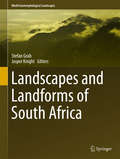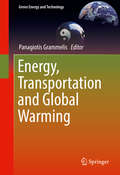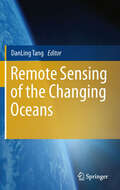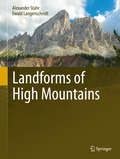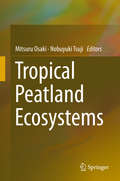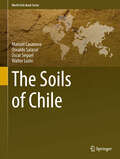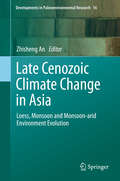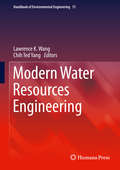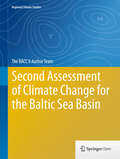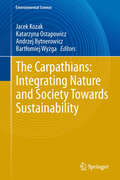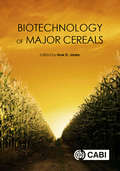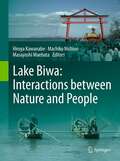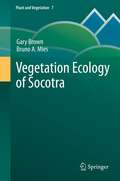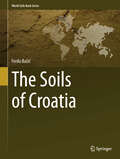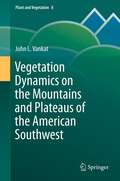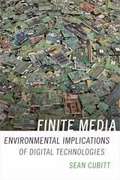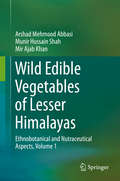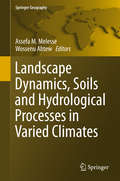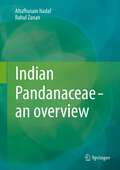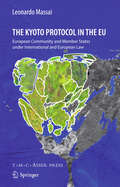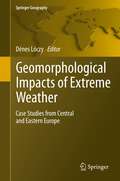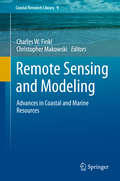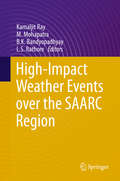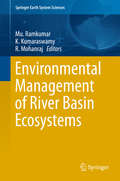- Table View
- List View
Landscapes and Landforms of South Africa
by Stefan Grab Jasper KnightThis book presents a beautifully illustrated overview of the most prominent landscapes of South Africa and the distinctive landforms associated with them. It describes the processes, origins and the environmental significance of those landscapes, including their relationships to human activity of the past and present. The sites described in this book include, amongst others, the Blyde River Canyon, Augrabies Falls, Kruger National Park, Kalahari desert landscapes, the Great Escarpment, Sterkfontein caves and karst system, Table Mountain, Cape winelands, coastal dunes, rocky coasts, Boer War battlefield sites, and Vredefort impact structure. Landscapes and Landforms of South Africa provides a new perspective on South Africa's scenic landscapes by considering their diversity, long and short term histories, and importance for geoconservation and geotourism. This book will be relevant to those interested in the geology, physical geography and history of South Africa, climate change and landscape tourism.
Energy, Transportation and Global Warming
by Panagiotis GrammelisThis book presents a holistic view of climate change by examining a number of energy and transportation technologies and their impact on the climate. High-quality technical research results from specific test-cases around the globe are presented, and developments in global warming are discussed, focusing on current emissions policies from air and maritime transport to fossil fuel applications. Novel technologies such as carbon capture and storage are investigated together with the corresponding process and systems analysis, as well as optimization for mitigating CO2 emissions. Water resources management, waste water treatment, and waste management issues are also covered. Finally, biomass, hydrogen and solar energy applications are presented along with some insights on green buildings. Energy, Transportation and Global Warming is of great interest to researchers in the field of renewable and green energy as well as professionals in climate change management, the transportation sector, and environmental policy.
Remote Sensing of the Changing Oceans
by Danling TangRemote Sensing of the Changing Oceans is a comprehensive account of the basic concepts, theories, methods and applications used in ocean satellite remote sensing. The book provides a synthesis of various new ideas and theories and discusses a series of key research topics in oceanic manifestation of global changes as viewed from space. A variety of research methods used in the analysis and modeling of global changes are introduced in detail along with numerous examples from around the world's oceans. The authors review the changing oceans at different levels, including Global and Regional Observations, Natural Hazards, Coastal Environment and related scientific issues, all from the unique perspective of Satellite Observation Systems. Thus, the book not only introduces the basics of the changing oceans, but also new developments in satellite remote sensing technology and international cooperation in this emerging field. Danling Tang (Lingzis) received her Ph.D from Hong Kong University of Science and Technology. She conducted research and teaching in Hong Kong, USA, Japan, and South Korea for more than 10 years; in 2004, she received "100 Talents Program of Chinese Academy of Sciences" and returned to China. She was a professor of Fudan University, and now is a Leading Professor of "Remote Sensing of Marine Ecology and Environment" at the South China Sea Institute of Oceanology, Chinese Academy of Sciences. Dr. Tang has been working on satellite remote sensing of marine ecology and environment; her major research interests include ocean dynamics of phytoplankton bloom, global environmental changes, and natural hazards. Dr. Tang has organized several international conferences, workshops, and training, she also services as member of organizing committee for several international scientific organizations; she was the Chairman of the 9th Pan Ocean Remote Sensing Conference (PORSEC 2008), and currently is the President-elect of PORSEC Association.
Landforms of High Mountains
by Alexander Stahr Ewald LangenscheidtThis image atlas and reference book is written in simple language that can be understood by a broad audience. The work comprehensively explains the geomorphological forms of high mountains using many examples like glacial erosion forms and deposits such as moraines and gravel terraces, which are illustrated with numerous photographs. Landslide landscapes, volcanoes, weathering, and erosion are other examples discussed. These examples are from across the world, including the Himalayas, the Alps, the Andes, and the Southern Alps of New Zealand. This work is useful for laymen who are interested in geosciences, especially high-mountain landforms, as well as for students and teachers of earth sciences.
Tropical Peatland Ecosystems
by Mitsuru Osaki Nobuyuki TsujiThis book is an excellent resource for scientists, political decision makers, and students interested in the impact of peatlands on climate change and ecosystem function, containing a plethora of recent research results such as monitoring-sensing-modeling for carbon-water flux/storage, biodiversity and peatland management in tropical regions. It is estimated that more than 23 million hectares (62 %) of the total global tropical peatland area are located in Southeast Asia, in lowland or coastal areas of East Sumatra, Kalimantan, West Papua, Papua New Guinea, Brunei, Peninsular Malaysia, Sabah, Sarawak and Southeast Thailand. Tropical peatland has a vital carbon-water storage function and is host to a huge diversity of plant and animal species. Peatland ecosystems are extremely vulnerable to climate change and the impacts of human activities such as logging, drainage and conversion to agricultural land. In Southeast Asia, severe episodic droughts associated with the El Niño-Southern Oscillation, in combination with over-drainage, forest degradation, and land-use changes, have caused widespread peatland fires and microbial peat oxidation. Indonesia's 20 Mha peatland area is estimated to include about 45-55 GtC of carbon stocks. As a result of land use and development, Indonesia is the third largest emitter of greenhouse gases (2-3 Gtons carbon dioxide equivalent per year), 80 % of which is due to deforestation and peatland loss. Thus, tropical peatlands are key ecosystems in terms of the carbon-water cycle and climate change.
The Soils of Chile
by Manuel Casanova Oscar Seguel Osvaldo Salazar Walter LuzioThis book is intended for students and soil scientists who want to know about the state of the art in soil sciences in Chile. The book merges a comprehensive bibliographical review of the soil surveys carried out throughout the length and breadth of Chilean territory during the past 40 years and more recent information obtained by the authors in a number of field studies. As its starting point the book presents a general overview of important features related to Chilean soils, such as geology and geomorphology, climate, land use and vegetation. In this long and narrow country different soil formation factors and processes have resulted in a broad variety of soil bodies, from the extremely arid Atacama desert to the Patagonian and Antarctic zones. This book provides a description and classification (mainly Soil Taxonomy) of the most important soil types. Particularly important are soils derived from volcanic materials, which cover extensive areas of Chile. The book also deals with soil management topics in relation to the chemical, physical and biological properties of Chilean soils and it includes a number of examples from throughout the country. Finally, the book shows how man has induced severe soil degradation problems in Chile, such as erosive soil degradation, non-erosive soil degradation and land desertification.
Late Cenozoic Climate Change in Asia
by Zhisheng AnThis book is the first of its kind on environmental change research devoted to monsoon-arid environment evolution history and its mechanism involved. Capturing the most prominent features of Asian climate and environmental changes, it gives a comprehensive review of the Asian Monsoon records providing evidence for spatial and temporal climatic and environmental changes across the Asian continent since the Late Cenozoic. The dynamics underlying these changes are explored based on various bio-geological records and in particular based on the evidence of loess, speleothems as well as on mammal fossils. The Asian monsoon-arid climate system which quantifies the controlling mechanisms of climate change and the way it operates in different time scales is described. Attempts to differentiate between natural change and human-induced effects, which will help guide policies and countermeasures designed to support sustainable development on the Chinese Loess Plateau and the arid west.
Eating Vegan in Philly
by Vance LehmkuhlEating Vegan in Philly is the latest volume in the Vegan City Guides series, published by Sullivan Street Press. The author, Vance Lehmkuhl, is the vegan columnist for the Philadelphia Daily News, V for Veg, and also writes the philly.com blog, V for Vegan. With this expertise, he covers the historical roots of the vegetarian/vegan scenes in Philadelphia and the rise over the last 50 years of a vital and important restaurant and food scene devoted to plant-based living. This book offers travelers a guidebook to all the vegan and vegan friendly restaurants in the area along with some of the most interesting sites and sights in Philadelphia to experience.
Modern Water Resources Engineering
by Lawrence K. Wang Chih Ted YangThe Handbook of Environmental Engineering series is an incredible collection of methodologies that study the effects of pollution and waste in their three basic forms: gas, solid, and liquid. This exciting new addition to the series, Volume 15: Modern Water Resources Engineering , has been designed to serve as a water resources engineering reference book as well as a supplemental textbook. We hope and expect it will prove of equal high value to advanced undergraduate and graduate students, to designers of water resources systems, and to scientists and researchers. A critical volume in the Handbook of Environmental Engineering series, chapters employ methods of practical design and calculation illustrated by numerical examples, include pertinent cost data whenever possible, and explore in great detail the fundamental principles of the field. Volume 15: Modern Water Resources Engineering, provides information on some of the most innovative and ground-breaking advances in the field today from a panel of esteemed experts.
Second Assessment of Climate Change for the Baltic Sea Basin
by The BACC II Author TeamThis book is an update of the first BACC assessment, published in 2008. It offers new and updated scientific findings in regional climate research for the Baltic Sea basin. These include climate changes since the last glaciation (approx. 12,000 years ago), changes in the recent past (the last 200 years), climate projections up until 2100 using state-of-the-art regional climate models and an assessment of climate-change impacts on terrestrial, freshwater and marine ecosystems. There are dedicated new chapters on sea-level rise, coastal erosion and impacts on urban areas. A new set of chapters deals with possible causes of regional climate change along with the global effects of increased greenhouse gas concentrations, namely atmospheric aerosols and land-cover change. The evidence collected and presented in this book shows that the regional climate has already started to change and this is expected to continue. Projections of potential future climates show that the region will probably become considerably warmer and wetter in some parts, but dryer in others. Terrestrial and aquatic ecosystems have already shown adjustments to increased temperatures and are expected to undergo further changes in the near future. The BACC II Author Team consists of 141 scientists from 12 countries, covering various disciplines related to climate research and related impacts. BACC II is a project of the Baltic Earth research network and contributes to the World Climate Research Programme.
The Carpathians: Integrating Nature and Society Towards Sustainability
by Andrzej Bytnerowicz Bartłomiej Wyżga Jacek Kozak Katarzyna OstapowiczThe book includes a broad spectrum of perspectives from different scientific disciplines (both the natural and social sciences) as well as practical knowledge. It gives a new insight into the Carpathian mountain region
Biotechnology of Major Cereals
by Huw D. JonesBiotechnology of Major Cereals will focus on the recent advances and future prospects in cereal biotechnology. The first part of the book will cover the world's major cereals and focus on new developments and trends. The second part will be technology rather than species-led, detailing fundamental developments in technologies and significant target traits.
Lake Biwa: Interactions between Nature and People
by Hiroya Kawanabe Machiko Nishino Masayoshi MaehataThis book focuses on the long-term interactions between people and nature in and around Lake Biwa, one of the oldest lakes in the world. Accordingly, it not only covers the characteristics of the biota of this ancient lake, but also approaches it as a 'cultural ancient lake.' Furthermore, various problems affecting the lake, especially recent environmental changes that occurred before and after Japan's rapid economic growth of the 1950s and 60s, are reviewed, including water pollution, lakeshore development and the reclamation of attached lakes, alien and invasive species, and problems related to the recent warming of the climate. Lastly, by analyzing data on these problems collected by the local government and residents of the lake basin, the book provides a comprehensive outlook on the future of Lake Biwa and people's lifestyles. As such, it provides indispensable information for all people engaged in improving and conserving water regimes around the world, as well as people interested in the culture and history of Japan.
Vegetation Ecology of Socotra
by Bruno Mies Gary BrownAlthough the unique flora of the Socotra Archipelago with its high degree of endemism has received much attention recently, little information is available on the vegetation and related ecological aspects. Based on their extensive field experience of the region, the authors have assimilated a vast amount of knowledge to produce this book, which gives a detailed insight into the plant ecology of Socotra, designated as a World Heritage Site by UNESCO in 2008. The book is divided into seven chapters. After a brief introduction and overviews of important abiotic features, various aspects of the vascular flora are presented in Chapter 4, together with accounts of the bryophyte and lichen flora. Ecology and adaptive strategies of the plants are dealt with in Chapter 5, and Chapter 6 gives a concise description of the main vegetation units. Finally, important management issues of the vegetation are discussed, an essential topic to ensure preservation of the natural heritage of the archipelago.
The Soils of Croatia
by Ferdo BašićThe Soils of Croatia is a six-chapter book detailing all aspects of Croatian soils. The book presents, in a reader friendly way, the lively history of pedology in Croatia. It explains soils as natural resources for this country and offers a detailed view on the different agricultural regions referenced in Croatia. The Soils of Croatia also contains useful information regarding the different factors of soil genesis in the different regions as well as on soil taxonomy and it gives a very detailed classification of different Croatian Soils. Overall, this book contains everything that pedologists, students and anyone else interested in Croatian soils should know about.
Vegetation Dynamics on the Mountains and Plateaus of the American Southwest
by John VankatThe book provides information essential for anyone interested in the ecology of the American Southwest, including land managers, environmental planners, conservationists, ecologists and students. It is unique in its coverage of the hows and whys of dynamics (changes) in the major types of vegetation occurring on southwestern mountains and plateaus. It explains the drivers and processes of change, describes historical changes and provides conceptual models that diagrammatically illustrate past, present, and potential future changes. All major types of vegetation are covered: spruce-fir, mixed conifer, and ponderosa pine forests, pinyon-juniper vegetation, subalpine-montane grassland, and Gambel oak and interior chaparral shrublands. The focus is on vegetation that is relatively undisturbed, i.e., in natural and near-natural condition, and how it responds to natural disturbances such as fire and drought, as well as to anthropogenic disturbances such as fire exclusion and invasive species
Finite Media: Environmental Implications of Digital Technologies
by Sean CubittWhile digital media give us the ability to communicate with and know the world, their use comes at the expense of an immense ecological footprint and environmental degradation. In Finite Media Sean Cubitt offers a large-scale rethinking of theories of mediation by examining the environmental and human toll exacted by mining and the manufacture, use, and disposal of millions of phones, computers, and other devices. The way out is through an eco-political media aesthetics, in which people use media to shift their relationship to the environment and where public goods and spaces are available to all. Cubitt demonstrates this through case studies ranging from the 1906 film The Story of the Kelly Gang to an image of Saturn taken during NASA's Cassini-Huygens mission, suggesting that affective responses to images may generate a populist environmental politics that demands better ways of living and being. Only by reorienting our use of media, Cubitt contends, can we overcome the failures of political elites and the ravages of capital.
Wild Edible Vegetables of Lesser Himalayas
by Arshad Mehmood Abbasi Munir Hussain Shah Mir Ajab KhanOur intention with this book was to present the reader with the most accurate, significant, and up-to-date background and knowledge in the areas of ethnomedicinal and nutraceutical vegetation for the Lesser Himalayas in a comprehensive text. Wild Edible Vegetables of Lesser Himalayas provides a complete review of over 50 important plants of this region and details each species including photographs, botanical name, local name, family, flowering and fruiting period, status and habitat, parts used, distribution, ethnobotanical uses, cultural aspects, medicinal uses, and nutraceutical aspects. Medicinal uses include mode of preparation, method of application and diseases studied; cultural aspects and index; nutraceutical data provides analysis of fats, proteins, fibers, carbohydrates, ash, moisture content, dry matter, and energy value; elemental analysis includes various essential and toxic metals; phytochemical screening includes total phenolics, flavonoids, flavonols and ascorbic acid, and antioxidant potential in terms of DPPH scavenging activity, hydroxyl radical scavenging activity, H2O2 scavenging activity, Fe2+ chelating activity, ferric reducing antioxidant power, and phosphomolybdenum assay for each species. Wild Edible Vegetables of Lesser Himalayas is a concise and handy guide for scientists, scholars, and students interested in the study of agriculture, food science, nutraceutical science, bioscience, biodiversity, applied ethnobotany, ethnoecology, and ecology.
Landscape Dynamics, Soils and Hydrological Processes in Varied Climates
by Assefa M. Melesse Wossenu AbtewThe book presents the processes governing the dynamics of landscapes, soils and sediments, water and energy under different climatic regions using studies conducted in varied climatic zones including arid, semi-arid, humid and wet regions. The spatiotemporal availability of the processes and fluxes and their linkage to the environment, land, soil and water management are presented at various scales. Spatial scales including laboratory, field, watershed, river basin and regions are represented. The effect of tillage operations and land management on soil physical characteristics and soil moisture is discussed. The book has 35 chapters in seven sections: 1) Landscape and Land Cover Dynamics, 2) Rainfall-Runoff Processes, 3) Floods and Hydrological Processes 4) Groundwater Flow and Aquifer Management, 5) Sediment Dynamics and Soil Management, 6) Climate change impact on vegetation, sediment and water dynamics, and 7) Water and Watershed Management.
Indian Pandanaceae - an overview
by Altafhusain Nadaf Rahul ZananIndian screw pine family Pandanaceae represents three genera, in which genus Pandanus and Benstonea are distributed in two hotspots in India - the Western Ghats and the Northeast Himalayan region. For the first time, Indian Pandanaceae has been assessed for its taxonomic status and phylogenetic relationship. The extensive survey by the authors led to the discovery of three new Pandanus species (two from the Western Ghats and one from the Northeast Himalaya). The present taxonomic revision confirmed total number of Pandanus species to 14 that are distributed in the Southern India (9 species) and Northeast Himalayan region (5 species). Genus Benstonea is represented by two species, one from Southern India and another species common to both regions. A detailed species identification key is given along with conservation status of each species following IUCN Red List Categories and Criteria (2001). The study revealed that, out of 16 Pandanus and Benstonea species, six species are under threatened categories. In recent years, a chloroplast DNA-based molecular phylogenetic approach has been followed to understand the evolutionary relationship among the plant species. The interrelationship among the 14 Pandanus species at infrageneric level has been worked out using this approach, which has led to the rearrangement of some species to the subgenera proposed by Stone (1974). Moreover, the close relationship between Pandanus and Benstonea has been confirmed and the interrelationship of Indian Pandanus genus in global context is given. This book also describes the economic importance of each Pandanus species.
The Kyoto Protocol in the EU
by Leonardo MassaiThe participation of the European Community and the Member States in the international climate change regimes is a complex issue. In the case of the Kyoto Protocol, this is rendered more complicated by the fact that, for the purposes of Article 4 of the Kyoto Protocol, the membership of the European Community and Member States is frozen at a particular point in time. The result of this is that, under international law, the European Community and a part of the Member States (EU15) have agreed to jointly fulfil some of those obligations, whereas under community law all Member States share a certain degree of responsibility to meet the obligations created by the Kyoto Protocol. This book analyses in great detail the Kyoto Protocol and the obligations established, such as monitoring and reporting obligations, eligibility criteria and reduction commitments.
Geomorphological impacts of extreme weather
by Denes LoczyThis book presents new research on the geomorphological impacts of extreme precipitation events. It focuses on the extreme summer floods, which affected Central and Eastern Europe in 2010. Case studies on their consequences, including inundations, urban flooding, soil erosion, river bank retreat, alluvial fan accumulation, evolution of karst depressions, debris flows, landslides and soil saturation are presented for Poland, the Czech Republic, Ukraine, Slovakia, Hungary, Romania, Slovenia, Croatia, Serbia, Bulgaria and Macedonia. This key applied geomorphology book is crucial for anyone interested in these processes and their consequences and also for decision makers who face these catastrophes.
Remote Sensing and Modeling
by Charles W. Finkl Christopher MakowskiThis book is geared for advanced level research in the general subject area of remote sensing and modeling as they apply to the coastal marine environment. The various chapters focus on the latest scientific and technical advances in the service of better understanding coastal marine environments for their care, conservation and management. Chapters specifically deal with advances in remote sensing coastal classifications, environmental monitoring, digital ocean technological advances, geophysical methods, geoacoustics, X-band radar, risk assessment models, GIS applications, real-time modeling systems, and spatial modeling. Readers will find this book useful because it summarizes applications of new research methods in one of the world's most dynamic and complicated environments. Chapters in this book will be of interest to specialists in the coastal marine environment who deals with aspects of environmental monitoring and assessment via remote sensing techniques and numerical modeling.
High-Impact Weather Events over the SAARC Region
by Kamaljit Ray M. Mohapatra B. K. Bandyopadhyay L. S. RathoreThis book is a compilation of papers contributed by researchers and scientists from SAARC nations and deals with high-impact weather conditions, their prediction and potential consequences for populations in the SAARC region. There have been a number of recent advances in our understanding and prediction of cyclones, severe thunderstorms, squalls, heat and cold waves, droughts and heavy rainfall, based on the latest observational data and NWP modeling platform. The SAARC region is vulnerable to high-impact weather events because of geophysical features like high mountains, plateaus and vast oceans. As our climate continues to change over the coming years, the likelihood of extreme and potentially high-impact weather and climate events will be at its highest when natural and anthropogenic effects combine. All chapters were written by leading experts in their respective research and operational fields. The book reviews the latest research, future needs, forecasting skills and societal impacts of extreme weather events and offers high-quality reference material for weather forecasters, disaster managers and researchers.
Environmental Management of River Basin Ecosystems
by Mu. Ramkumar K. Kumaraswamy R. MohanrajThis book offers a unique collection of inter- and multidisciplinary studies on river systems. Rivers have been the prime source of sustenance since the advent of civilization and river systems often form the basis for agriculture, transport, water, and land for domestic, commercial, and industrial activities, fostering economic prosperity. A river basin is a basic geographical and climatological unit within which the vagaries of natural processes act and manifest themselves at different spatio-temporal scales. Even if compared side-by-side, no two river basins respond to natural processes in the same way and thus, it has long been recognized that each river basin is unique. Hence, any developmental activity or conservation effort has to be designed and implemented to match each unique river basin. With the burgeoning population and increasing dependency on natural resources, understanding and maintaining river systems has become increasingly important. This book provides a varied reference work on and unprecedented guidelines for conducting and implementing research on river basins, and for managing their ecological development.
